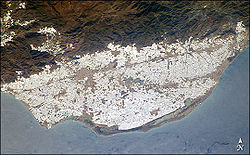Examples
From US Space Shuttles, which typically orbited at around 135 mi (217 km), cities were easily distinguishable from surrounding countryside. [1] Using binoculars, astronauts could even see roads, dams, harbors, even large vehicles such as ships and planes. [2] [6] At night, cities are also easily visible from the higher orbit of the ISS.
Metropolitan areas are clearly visible at night, particularly in industrialized countries, due to a multitude of street lights and other light sources in urban areas (see light pollution).
Cooling pond of Chernobyl

The 10-kilometre (6.2 mi) long cooling pond of the Chernobyl Nuclear Power Plant is visible from space. In April 1997 it was photographed from the Mir space station, which was in orbit somewhere between 296 km (184 mi) and 421 km (262 mi).
The Greenhouses of Almería

The greenhouse complex that covers about 26 thousand hectares (64 thousand acres; 100 square miles) in the province of Almería, Andalucía, Spain [7] is visible from space. [8] It is sometimes referred to as the "Plastic sea" ("Mar de plástico" in Spanish) due to the high concentration of these greenhouse structures.
This area produces much of the fruit and vegetables that are sold in the rest of Spain and Europe. Apart from the area depicted in the photo, other zones of the province of Almería (and also the south of Spain) have large concentrations of white-plastic greenhouses too.
Bingham Canyon Mine

The Bingham Canyon Mine, more commonly known as Kennecott Copper Mine, [9] is an open-pit mining operation extracting a large porphyry copper deposit southwest of Salt Lake City, Utah, in the Oquirrh Mountains. The mine is the largest human-made excavation in the world. [10]